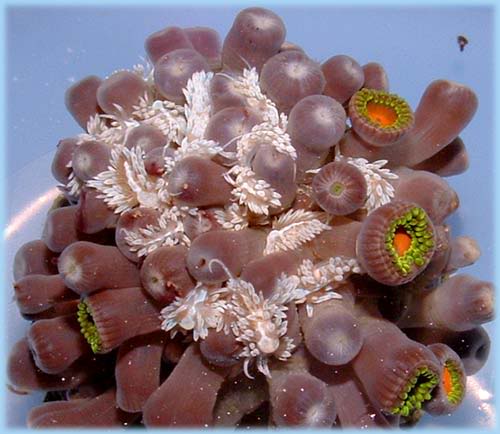


What is your feeding schedule like? Do you broadcast food all over the tank in a large quantity giving the Aiptasia time to catch some? Perhaps consider slowing down the feeding and feed the fish a small amount at a time to ensure that they eat all the food and none goes to the Aiptasia. If you’ve got a hundred though, consider why you’ve got a hundred. What is the situation? Have you got one Aiptasia or one hundred? If you’ve got one, I would place a wager that you’ve got a few more lurking about unseen for now but you’re still in a good place, you’re ahead of the problem.

What do they want? World domination! I joke, or maybe they do, who knows? Ultimately like all creatures they’re looking for a place to survive and multiply as much as they can and maybe that place is your reef tank! Here’s what you can do Like all anemones they can retract and shrink down to a tiny size which makes them almost impossible to see on coral frag plugs sometimes and certainly on Live Rock because they will secure themselves in the little nooks and crannys. Annoying, right? So how did they get into your reef tank in the first place? They can come in on Live Rock, coral plugs and even in the water column if you’ve received aįish from an infected system (the latter being unlikely but possible). What makes it worse is that they can often split as a response to stress, such as you the reef keeper trying to get rid of them which is often why you find two small Aiptasia in the roughly the same place not long after trying to get rid of one larger Aiptasia. When the Aiptasia reproduce this way, they can quickly go from one to two, two to four, four to eight and so on and so on. Reproduce together to create a genetically new Aiptasia or if there is only one present in the reef tank it can split itself to create an identical clone. They reproduce quickly both sexually and asexually meaning, if there are two of them, they can These stinging tentacles can also sting coral in the aquarium and as they spread or grow, the tentacles can come into contact with more and more coral causing destruction for the reef tank and headaches for you. Like all other anemones they possess stinging barbs within their tentacles containing venom to catch and immobilise their prey. They are often brown, clear or sometimes under LED can look slightly brown/purple’ish. They have a long body or stem and long thin stinging tentacles. There are 17 different species however they all look similarly alike. Who is the Aiptasia? What does it want? How did it get here?Īiptasia are a family of anemone. So, if you find yourself facing off against this common enemy of the reef tank then don’t worry, we’ve all been there and there are a number of things you can do.įirstly, lets understand the enemy. The fact that they can enter our reef tanks so easily despite our best efforts and can remain undetected for some time makes them even more irritating. They are extremely hardy, surviving and multiplying in conditions that we would consider less than optimal for most coral to sometimes survive let alone grow makes Aiptasia so difficult to get rid of at times. Aiptasia are absolutely up there as one of the top three all-time annoying and unwanted reef tank pests.


 0 kommentar(er)
0 kommentar(er)
